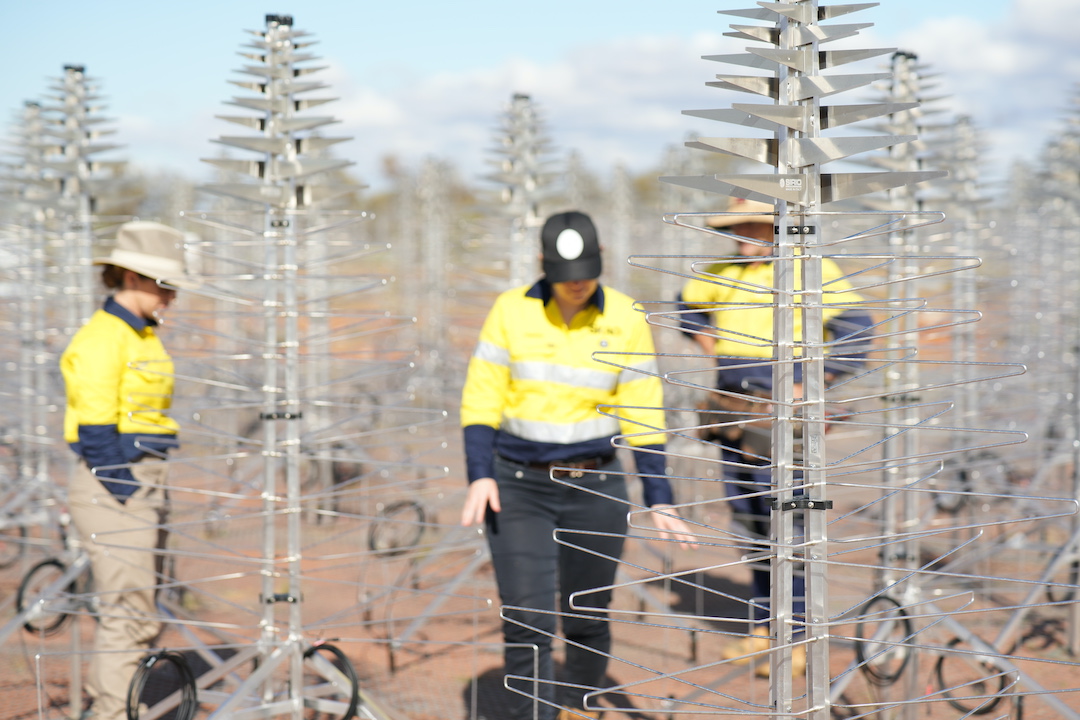In the vast expanse of Western Australia’s Murchison Shire, on the ancestral lands of the Wajarri Yamaji, a ground-breaking scientific endeavour is underway.
The CSIRO Murchison Radio-astronomy Observatory is known as Inyarrimanha Ilgari Bundara, or ‘sharing stars and sky’ in the local Wajarri language. This will be the site of the new Square Kilometre Array Observatory (SKAO) telescope, SKA-Low: one of the next generation of radio telescopes. With its partner SKA-Mid being constructed in South Africa, these two telescopes combined will make the largest radio observatory in the world.
You may be familiar with the traditional dish-style telescope, such as the famous Parkes radio telescope, Murriyang, which helped to broadcast the 1969 moon landing to the world. SKA-Low, however, is a bit more unconventional. The telescope is made up of over 130,000 Christmas tree-shaped antennas, each standing 2 metres tall. There are 256 antennas per station, and 512 stations all up, which will be distributed in a spiral arm pattern across the outback for 74 kilometres.
The antennas are made of horizontal ‘branches’ known as dipoles. They may be deceptively simple-looking, but at very low frequencies, these “wire” antennas are much more powerful and efficient. Combined with state-of-the-art back-end technologies, they collect a broad frequency of radio waves from a 419,000 square-metre area.

The Aperture Array Verification System 3 (AAVS3) being installed at the SKA-Low site in Western Australia © SKAO
Through a meticulous process, the signals received through the dipoles are amplified and transmitted to a Central Processing Facility in Perth at a staggering rate of 7.2 Tb/s.
What is most exciting about SKA-Low is that it can capture the “oldest” signals redshifted by the universe’s expansion to those originating closer to Earth. It will therefore be able to observe the first billion years of the universe, helping us to understand the births and deaths of the first-ever stars and give us insight into how the earliest galaxies were formed.
SKA-Low’s sheer scale promises a quantum leap in resolution, sensitivity, and survey speed. One of its defining features is its ability to digitally “point” at different directions in the sky, despite the stationary nature of its antennas. This capability, achieved through a process called ‘beamforming,’ enables astronomers to explore the cosmos with unparalleled precision.
As SKA-Low inches closer to fruition (with a completion date scheduled for 2029), the scientific community eagerly anticipates the revelations it will unveil about the universe’s infancy.
In an interesting side note, the same technology that powers SKA-Low’s antennas is finding unexpected applications, like a shark spotter app that utilises similar drone technology to detect sharks in Australian waters.
The universe, it seems, is not the only frontier SKA-Low is exploring.
Featured image: A composite image of the SKA-Low telescope, blending the existing AAVS2.0 prototype station in Western Australia with an artist’s impression of the future SKA-Low stations. Credit: SKAO
To learn about another exciting CSIRO initiative, click here.

